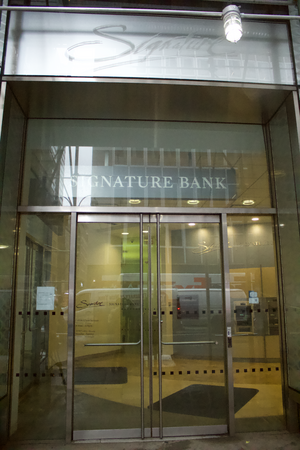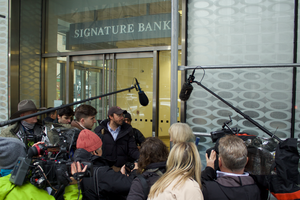Signature Bank facts for kids
 |
|
| Public company | |
| Traded as | NASDAQ: SBNY |
| Industry |
|
| Fate | Failed due to systemic risk and taken into receivership by the Federal Deposit Insurance Corporation |
| Founded | May 1, 2001 |
| Defunct | March 12, 2023 |
| Headquarters | New York City, New York, U.S. |
|
Key people
|
|
| Total assets | |
| Total equity | |
|
Number of employees
|
1,854 (2021) |
| Parent | Federal Deposit Insurance Corporation |
| Subsidiaries |
|
Signature Bank was a bank based in New York City. It offered many banking services to its customers. The bank had offices in New York, Connecticut, California, Nevada, and North Carolina.
Signature Bank also helped specific industries. These included real estate, private investment, and technology companies. The bank also had companies that helped with equipment financing and investment advice.
By the end of 2022, Signature Bank had about $110.4 billion in total assets. This means it had a lot of money and property. It also held $82.6 billion in deposits from its customers.
The bank was started in 2001 by people who used to work at another bank. They wanted to focus on building strong relationships with wealthy clients. For a long time, its offices were only in the New York City area.
Later, Signature Bank started to grow. It opened offices in new places. In 2018, it began working with cryptocurrency businesses. By 2021, a big part of its deposits came from these crypto companies.
New York banking officials closed Signature Bank on March 12, 2023. This happened two days after another bank, Silicon Valley Bank, failed. Many customers became worried and took out over $10 billion from Signature Bank. This made Signature Bank the third-largest bank failure in U.S. history.
Contents
How Signature Bank Started and Grew
Signature Bank first opened its doors on May 1, 2001. It was founded by Joseph J. DePaolo, Scott A. Shay, and John Tamberlane. Joseph DePaolo and John Tamberlane had previously worked at Republic National Bank of New York. They left after that bank was bought by HSBC.
Six branches opened at the same time in the New York City area. The goal was to serve wealthy clients and business owners. These were people who had at least $250,000 in assets. The bank aimed for "the guy who started his business in Brooklyn and is now worth $20 million."
An Israeli bank, Bank Hapoalim, provided over $60 million to help Signature Bank start. Many of its first employees came from Republic Bank. They joined Signature Bank just before it opened.
The bank grew quickly. By February 2003, it had $950 million in assets. It became one of the top banks in the U.S. and started making a profit. Signature Bank also made fewer loans than other banks. It invested its money in safer, lower-return options.
Becoming a Public Company
Signature Bank became a public company in March 2004. This meant its shares could be bought and sold on the NASDAQ stock market. Its stock symbol was SBNY.
The bank continued to grow fast, even though it only focused on the New York area. It became one of the fastest-growing public companies in New York. Signature Bank often hired bankers from other banks that had recently merged. These bankers would bring their clients with them.
The bank focused a lot on personal relationships with its clients. It did not even advertise. Its bank branches did not have street signs. From 2004 to 2014, its stock price went up by 650 percent. This was much higher than many other companies.
Expanding Services and Locations
In 2007, Signature Bank started to offer new types of business services. It began lending money for apartment buildings. In 2012, it expanded into equipment financing through its Signature Financial group.
The bank also became very important for law firms in New York. It had a large amount of money set aside. This helped protect its many customers whose accounts were larger than the $250,000 insured by the Federal Deposit Insurance Corporation (FDIC).
By 2017, the bank's total assets were close to $50 billion. In 2018, Signature Bank opened its first office on the West Coast in San Francisco. This was a big step for the bank. In 2020, it opened more offices in Southern California. In 2022, it added an office in Reno, Nevada.
Signature Bank also started working in North Carolina in 2019. It hired many experienced bankers there. By 2021, it was one of the largest banks in the Durham–Chapel Hill area.
How Signature Bank Operated in Its Last Years
Banking Services for Clients
Signature Bank offered banking services for both businesses and individuals. It focused on lending money and taking deposits. The bank paid its bankers based on how much business they brought in. This was similar to how some sales companies work.
The bank was known for being very loyal to its clients. This encouraged clients to do more business with Signature. For example, a famous music producer named Irv Gotti became a loyal customer. Signature Bank allowed him to use its services even when other banks would not.
By 2022, the bank had nine main business areas. These included lending for commercial real estate and working with private investment firms. It also helped technology companies and offered specialized mortgage services.
Signature Bank also had two other companies that provided services. Signature Securities Group Corporation gave investment advice. Signature Financial LLC helped with equipment financing and leasing.
Focus on Cryptocurrency
In its final years, Signature Bank started working with cryptocurrency companies. It began accepting them as customers in 2018. This helped make the crypto industry seem more official.
By 2021, over 16 percent of the bank's deposits came from crypto businesses. This number grew to 30 percent by February 2023. The bank also held money for a popular cryptocurrency called USDC.
Working with crypto businesses made the bank's stock price go up a lot. But it also made the bank seem like a "crypto bank." The bank's founder, Joseph DePaolo, tried to change this image.
The bank started to see money being taken out by both crypto and other customers. Some investors worried about the bank's ability to pay back all its customers. The bank then tried to reduce its involvement in the crypto world.
In February 2023, Joseph DePaolo announced he would leave his role as CEO. This was not related to problems in the crypto market. He had been the bank's only CEO for almost 22 years.
The main part of its crypto business was called Signet. This was a payment network launched in 2019. It allowed approved clients to send money instantly using blockchain technology. There were no extra fees or middlemen. By the end of 2020, 740 clients were using Signet.
Why Signature Bank Failed
On Sunday, March 12, 2023, Signature Bank was closed by New York state officials. This happened because the bank could not find a buyer or get enough money to protect its assets. Customers had started taking out their deposits very quickly.
The bank's failure was seen as a big risk to the entire financial system. This allowed the government to take special steps. These steps made sure that all customers would get their money back, even if their deposits were more than the $250,000 usually insured by the Federal Deposit Insurance Corporation (FDIC).
The FDIC took over the bank. It created a new bank called Signature Bridge Bank, N.A. The FDIC would run this new bank while trying to sell its assets. Greg D. Carmichael was named the CEO of this temporary bank.
At the end of 2022, about 90 percent of the bank's $89 billion in deposits were more than the FDIC's insurance limit. But all depositors were expected to get their money back. However, people who owned stock or bonds in Signature Bank might lose their money.
The Rapid Collapse
Signature Bank's closure happened very quickly. It surprised many people inside the bank. Even though a lot of money was taken out on Friday, bank leaders thought they had enough funds to handle it.
Former U.S. congressman Barney Frank was on the bank's board. He said that after Silicon Valley Bank failed, Signature Bank's clients worried about its crypto connections. They started taking out their money. This created a "panic" that began late on Friday. That day, customers withdrew over $10 billion.
One expert, Christopher Whalen, said the bank failed because of its involvement with cryptocurrency. He called it a "huge mistake" by experienced bankers.
Signature Bank's failure affected several industries. A company called Circle, which manages the USDC stablecoin, told customers it could not process USDC through Signet after the bank closed. Another crypto company, Coinbase, had $240 million with Signature. It said its customers could only use Signet during regular banking hours.
Signature Bank was also a very important source of money for real estate projects in New York. It provided most of its $33 billion in outstanding mortgage loans. It also played a big role in lending for rent-controlled properties.
A general manager on Broadway said that the government's takeover of the bank was a good thing. Signature Bank was one of two main banks used by theater productions. Without the government's help, some shows might not have been able to pay their staff.
See also
 In Spanish: Signature Bank para niños
In Spanish: Signature Bank para niños


